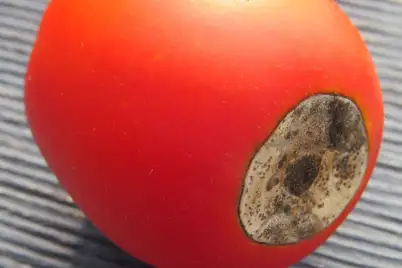Small, circular lesions appear on the leaves in spring. They are brown with reddish margins and as they enlarge (to a max diameter of 7 mm), they develop black interveinal margins and grey-tan or red-brown centres. The spore-bearing structures of the pathogen, also known as pycnidia, appear in the centre of the lesions and are visible as small, black dots.
On new shoots, stems and tendrils, the lesions are tan before becoming sunken and purple-black. They may be elliptical or elongated. Pycnidia may be present and as the canes grow, the bark may split.
On fruit, small, pale dots (1 mm) appear and are surrounded by a widening brown halo. If left untreated, the brown lesions continue to expand until the fruit becomes completely covered and begins to rot. Berries shrivel and turn dark brown with various pycnidia developing on the surface. Ultimately, the fruit dry and shrivel, turning into hard blue-black mummies that may fall or remain on the vine.
The symptoms look very similar to symptoms caused by other diseases, such as Black Spot or Anthracnose (Elsinoe ampelina), Alternaria spp., Botrytis cineraria, or Phomopsis Cane and Leaf Spot (Diaporthe ampelina). However, the presence of pycnidia in the lesions is usually a tell-tale sign of Phyllosticta ampelicida, but a DNA sequence analysis can also be used to confirm the presence of the pathogen.








